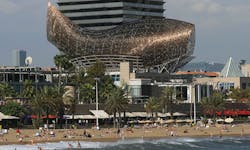From Gehry to the High Line: What makes a project a game-changer?
In 1977, when engineers with French aircraft maker Dassault Aviation developed a revolutionary 3D CAD tool for its Mirage fighter jet project, architectural design surely was the last application on their minds. Fifteen years later, along came a couple of frustrated architects who were attempting to build a giant golden fish.
The software tool was CATIA. The fish: the shimmering El Peix sculpture on Barcelona’s waterfront, designed as an Olympic Village pavilion for the 1992 games. The architects? I’m sure you guessed by now: Frank Gehry and his long-time tech maestro (and later, Founder of Gehry Technologies), Jim Glymph, FAIA.
Using the industrial design tool, Gehry and Glymph were able to execute the sinuous design scheme, with its curved metal skin and hundreds of unique connections to the internal steel structure, in a matter of months. Moreover, the architectural design team was able to communicate the structure’s complex design to the structural engineer and contractor, so that the components could be fabricated to precise specifications. The entire project, from documentation to erection, was executed in just six months.
For a special report for the January 2016 issue of BD+C, “Game-changers: 7 Projects That Rewrite the Rules of Design+Construction,” the editors are looking for projects—recently completed or in the works—that break the mold of traditional design and construction. To submit your project for consideration, email a project summary and images/renderings to [email protected] by November 2.
The duo would later implement their newly discovered tool on two of Gehry’s most noted projects: the Guggenheim Museum Bilbao, in Spain, and the Disney Concert Hall, in Los Angeles. The Gehry–CATIA story was born, and parametric modeling began to take hold in the U.S.
Each year, there are a handful of projects like Gehry’s El Peix sculpture that significantly advance the AEC industry or a particular building type. In the green building world, the Chesapeake Bay Foundation’s Philip Merrill Environmental Center in Annapolis, Md. (the first LEED Platinum building), and Oberlin (Ohio) College’s Adam Joseph Lewis Center for Environmental Studies, with its Living Machine wastewater treatment and reuse system, come to mind.
In high-rise design, we look to Rem Koolhaas’s 3D-cranked-loop scheme for the China Central Television (CCTV) headquarters in Beijing, Santiago Calatrava’s Turning Torso in Malmö, Sweden, and the mind-boggling-tall Burj Khalifa, by Adrian Smith (in his SOM days).
In prefabrication construction, projects like Skanska and NBBJ’s Miami Valley Hospital Heart and Orthopedic tower in Dayton, Ohio (one of the first healthcare projects to implement MEP multi-trade racks), paved the way.
Then there’s the High Line, in Manhattan, by Field Operations and Diller Scofidio + Renfro. The elevated-rail-line-turned-park has been such a resounding success that cities across the globe are racing to emulate its linear park template.
I can go on and on naming landmark projects, but I’d rather turn things over to you. For a special report for the January 2016 issue of BD+C, “Game-changers: 7 Projects That Rewrite the Rules of Design+Construction,” the editors are looking for projects—recently completed or in the works—that break the mold of traditional design and construction. Maybe they involve the implementation of advanced tools or methods, the use of clever project financing mechanisms, or the installation of a first-of-its-kind HVAC scheme or novel material. These are just a few ideas to get your creative juices flowing.
To submit your project for consideration, email a project summary and images/renderings to [email protected] by November 2. We look forward to telling the next Gehry–CATIA story!
About the Author

David Barista
David Barista is Editorial Director of Building Design+Construction and BDCnetwork.com, properties that combined reach more than 100,000 commercial building professionals, including architects, engineers, contractors, and building owners. David has covered the U.S. construction industry for more than a decade, previously serving as Editor-in-Chief of BD+C, Professional Builder, Custom Builder, and HousingZone.com. He has won numerous editorial awards, including six Jesse H. Neal Awards and multiple honors from the Construction Writers Association and the American Society of Business Publication Editors.
Email: [email protected]
